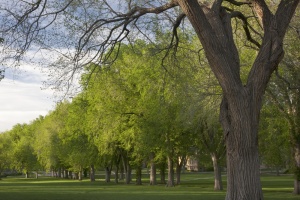Ulmus rubra
| See Also | Botanical Monographs |
|---|
Slippery Elm (Ulmus rubra) is known for its ability to soothe inflamed mucous membranes of the digestive, respiratory and urinary systems as well as a number of skin conditions. To explore the characteristics, medicinal uses and prescribing considerations of this herb in more detail, check out the references indicated.[1], [2]
Contents
Characteristics
- Common Names: Slippery Elm, Red Elm, Moose Elm, Indian Elm, American Elm
- Family: Ulmaceae
- Habitat: Ulmus rubra is native to North America. It thrives on high ground and dry soil. The species is considered "at risk".
- Parts Used: Inner bark
- Constituents: mucilage and tannins
- Medicinal Actions: demulcent, emollient, nutritive, astringent, anti-inflammatory, laxative, vulnerary
Uses
Historical Uses:
Ulmus rubra was used by Native North Americans for digestive complaints, fever, colds, urinary symptoms, and externally for wounds, boils, ulcers, and inflamed eyes.
Medicinal Uses:
- sensitive or inflamed mucous membranes of the gastrointestinal tract including gastritis, acidity, ulcers, gastroenteritis, colitis, diverticulitis, inflammatory bowel disease, irritable bowel syndrome, colic, hemorrhoids
- diarrhea, Dysentery, Constipation
- sore throat, cough, bronchitis, pleurisy, tuberculosis
- chronic cystitis
- Other Conditions
- vaginitis, convalescence
Topically
- boils, splinters, and abscesses (drawing action), ulcers, skin protection
- Other Conditions
Prescribing Considerations
The information provided is intended to augment the treatment from a naturopathic doctor or other trained medical professional. Although most herbs are generally safe, it is recommended that you avoid self-prescribing especially when there is an underlying ongoing medical condition, if you are on any prescription medications or if you are pregnant or breastfeeding.
Formulations and Preparation
- Infusion - 1-2 tsp of powdered root stirred into 1/2-1 cup of warm water three times daily
- Capsule - 200g three times daily for bronchitis
- Tablet - for diarrhea
- Poultice - mix coarse powdered root with enough boiling water to make a paste
Safety
The safety and prescribing considerations for this herb include:[3] [4]
- Generally regarded as safe.
- Side-effects are not generally seen.
- Bark may be abortifacient (producing abortion).
- Drug-Herb Interactions are rare.[2]
- May cause reduced absorption of oral drugs (speculative)
References
- ↑ Boon Heather, Smith Michael (2009) 55 Most Common Medicinal Herbs: The Complete Natural Medicine Guide Second Edition Institute of Naturopathic Education and Research, CCNM Toronto.
- ↑ 2.0 2.1 Godfrey Anthony, Saunders Paul, Barlow Kerry, Gowan Matt (2011) Principles and Practices of Naturopathic Botanical Medicine, Advanced Botanical Medicine. V3 CCNM Press, Toronto.
- ↑ Stargrove Mitchell Bebell, Treasure Jonathan, McKee Dwight L (2008) Herb, Nutrient and Drug Interactions: Clinical Implications and Therapeutic Strategies.
- ↑ Brinker Francis (1997) Herbal Contraindications and Drug Interactions: Plus Herbal Adjuncts With Medicines, 4th Edition Eclectic Medical Publications.
